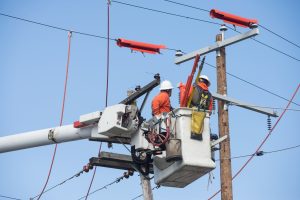Print a Sign-In Sheet | Spanish Version Coming Soon
Operating Aerial lifts near overhead lines has many potential hazards. However, by following safe work practices these exposures can be controlled.
- Equipment can only be operated by trained workers and within equipment rating and design limitations.
- Personnel working in an aerial lift must wear fall protection and cannot belt off to a pole or other structure.
- The lift controls of the bucket, derrick, and pole setting trucks, etc. must be tested before use each day to be sure they are in safe working condition.
- Critical safety components that affect raising, lowering, or rotating of lifts must be visually inspected before use on each shift for indications of any possible defects.
- When other workers are present, vehicles must not be backed up unless:
- The driver has a clear rearview and the vehicle has a back-up alarm or
- Another worker serves as a guide.
- If a vehicle has outriggers, they must be used unless the work area or terrain prevents their use.
- Vehicles may only be used within their maximum load limits and without outriggers if the manufacturer’s design and instructions indicate that it is safe to operate without the outriggers.
- Before outriggers are set, the operator must have a clear view of the outriggers and ensure all workers are clear of the outrigger’s motion.
- When a load is suspended from a boom, operators must remain at the controls unless it can be shown that there is no hazard to personnel, such as those created by a falling load, wind, or unstable soil.
- When operating near energized lines or equipment, aerial lift equipment must maintain the minimum approach distance unless the insulated portion of the aerial lift is operated by a 269-qualified employee. If necessary, another worker must be a spotter for the operator to ensure the minimum approach distance is maintained.
- If the aerial lift could contact energized lines, then at least one of the following must be done:
- The energized lines exposed to contact must be covered with insulating protective material that will withstand the type of contact that might be made during the operation; or
- The aerial lift must be insulated, and uninsulated portions of the lifts must maintain the minimum approach distance from live parts. The aerial lift must also be positioned so that uninsulated portions of the lift cannot come within the minimum approach distance from the live parts. (Note that insulated booms require electrical testing at voltages and intervals specified in ANSI A92.2. An untested boom or one that fails a test is considered non-insulating. See 1910.67(c)(3)); or
- Workers must be protected by implementing all the following:
- Each piece of equipment (trucks, trailers, etc.) must be grounded.
- All pieces of equipment must be bonded together.
- Ground mats must be used around equipment to extend the equipotential zone.
- Insulating protective equipment or barricades must be used around the equipotential zone.
KEMI does not assume liability for the content of information contained herein. Safety and health remain your responsibility. This information is to be used for informational purposes only and not intended to be exhaustive or a substitute for proper training, supervision or manufacturers’ instructions/recommendations. KEMI, by publication of this information, does not assume liability for damage or injury arising from reliance upon it. Compliance with this information is not a guarantee or warranty that you will be in conformity with any laws or regulations nor does it ensure the absolute safety of any person, place or object, including, but not limited to, you, your occupation, employees, customers or place of business.

